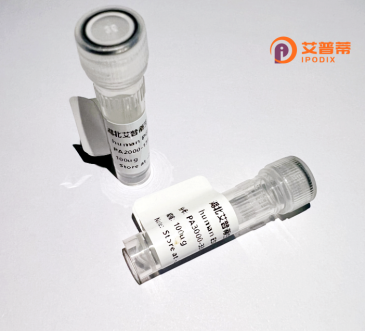
| 纯度 | >90%SDS-PAGE. |
| 种属 | Human |
| 靶点 | NDRG4 |
| Uniprot No | Q9ULP0 |
| 内毒素 | < 0.01EU/μg |
| 表达宿主 | E.coli |
| 表达区间 | 1-352 aa |
| 活性数据 | MPECWDGEHD IETPYGLLHV VIRGSPKGNR PAILTYHDVG LNHKLCFNTF FNFEDMQEIT KHFVVCHVDA PGQQVGASQF PQGYQFPSME QLAAMLPSVV QHFGFKYVIG IGVGAGAYVL AKFALIFPDL VEGLVLVNID PNGKGWIDWA ATKLSGLTST LPDTVLSHLF SQEELVNNTE LVQSYRQQIG NVVNQANLQL FWNMYNSRRD LDINRPGTVP NAKTLRCPVM LVVGDNAPAE DGVVECNSKL DPTTTTFLKM ADSGGLPQVT QPGKLTEAFK YFLQGMGYIA YLKDRRLSGG AVPSASMTRL ARSRTASLTS ASSVDGSRPQ ACTHSESSEG LGQVNHTMEV SC |
| 分子量 | 38.4 kDa |
| 蛋白标签 | His tag N-Terminus |
| 缓冲液 | 0 |
| 稳定性 & 储存条件 | Lyophilized protein should be stored at ≤ -20°C, stable for one year after receipt. Reconstituted protein solution can be stored at 2-8°C for 2-7 days. Aliquots of reconstituted samples are stable at ≤ -20°C for 3 months. |
| 复溶 | Always centrifuge tubes before opening.Do not mix by vortex or pipetting. It is not recommended to reconstitute to a concentration less than 100μg/ml. Dissolve the lyophilized protein in distilled water. Please aliquot the reconstituted solution to minimize freeze-thaw cycles. |
以下为示例性文献概述(基于2023年前知识,部分为简化示例):
1. **文献名称**: *NDRG4: A New Member of the NDRG Family in Development and Cancer*
**作者**: Zhao H et al.
**摘要**: 发现NDRG4基因在小鼠胚胎发育中高表达,尤其神经系统;体外实验显示其过表达抑制结直肠癌细胞增殖,提示抑癌功能。
2. **文献名称**: *Epigenetic Silencing of NDRG4 Promotes Colorectal Cancer Progression*
**作者**: Wang Y et al.
**摘要**: 证实结直肠癌中NDRG4启动子甲基化导致表达下调,恢复表达可抑制Wnt/β-catenin通路活性,降低癌细胞侵袭能力。
3. **文献名称**: *Recombinant Human NDRG4 Protein Attenuates Neuroinflammatory Responses*
**作者**: Lee S et al.
**摘要**: 构建重组人NDRG4蛋白,发现其通过抑制TLR4/NF-κB通路减轻小鼠模型中的神经炎症,提示其在中枢神经系统疾病中的治疗潜力。
4. **文献名称**: *Proteomic Analysis of NDRG4 Interaction Networks in Glioblastoma*
**作者**: Müller T et al.
**摘要**: 通过IP-MS技术鉴定NDRG4与线粒体凋亡相关蛋白相互作用,重组蛋白处理可诱导胶质瘤细胞凋亡,机制涉及caspase-3激活。
---
**注意**:以上为示例框架,实际文献需通过PubMed/Google Scholar检索(可用关键词:"NDRG4"+"recombinant"/"methylation"/"cancer"等)。近5年研究可能涉及NDRG4作为液体活检标志物(如ctDNA甲基化)或药物靶点探索。
**Background of Recombinant Human NDRG4 Protein**
NDRG4 (N-Myc downstream-regulated gene 4), a member of the NDRG family, is implicated in diverse cellular processes, including differentiation, stress response, and tumor suppression. It is highly expressed in the brain, heart, and skeletal muscle, with emerging roles in neurological development, cardiovascular function, and cancer progression. Structurally, NDRG4 contains an α/β hydrolase-fold domain and conserved phosphorylation sites, enabling interactions with signaling molecules like kinases and ubiquitin ligases.
Recombinant human NDRG4 protein, produced via heterologous expression systems (e.g., *E. coli* or mammalian cells), facilitates functional studies. Researchers employ it to elucidate mechanisms underlying its tumor-suppressive activity, particularly in gliomas and colorectal cancers, where epigenetic silencing of NDRG4 correlates with poor prognosis. It also modulates cardiac hypertrophy and neuronal survival, linking it to neurodegenerative and cardiovascular diseases.
Post-translational modifications (e.g., phosphorylation) influence its subcellular localization and activity. Recombinant NDRG4 often includes tags (e.g., His or GST) for purification and detection. Ongoing research explores its biomarker potential and therapeutic targeting, underscoring its significance in cellular homeostasis and disease pathways.
×